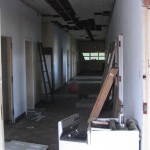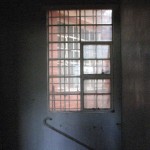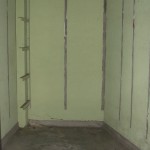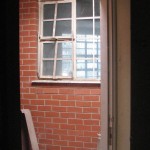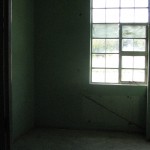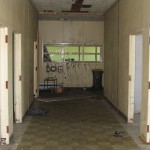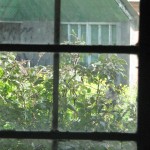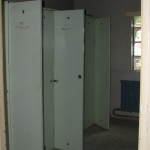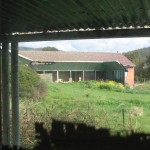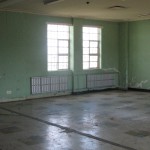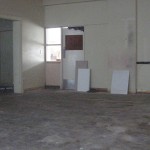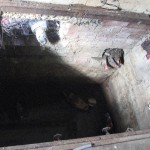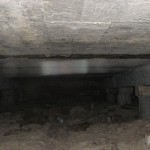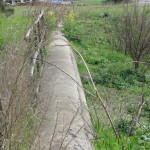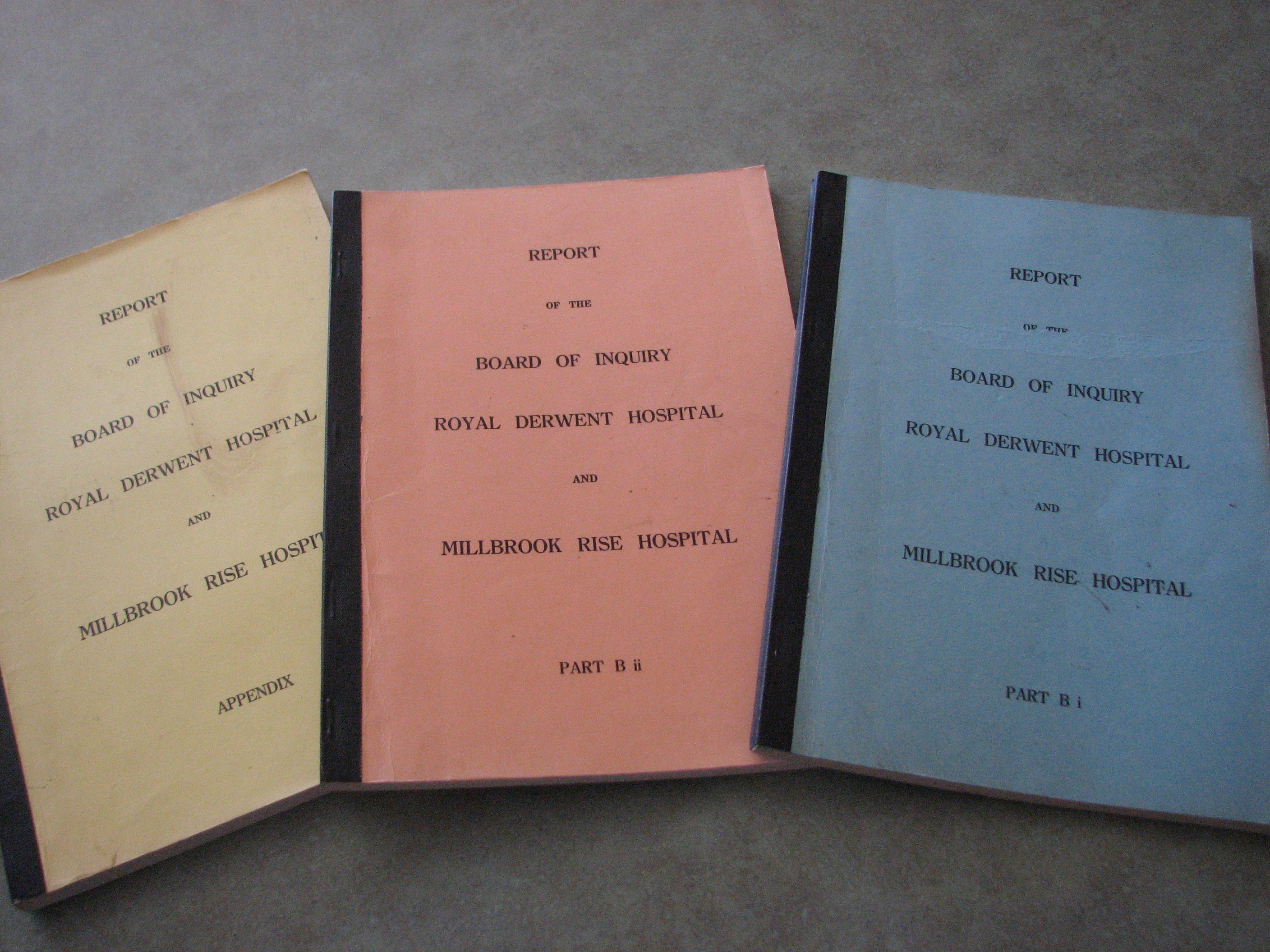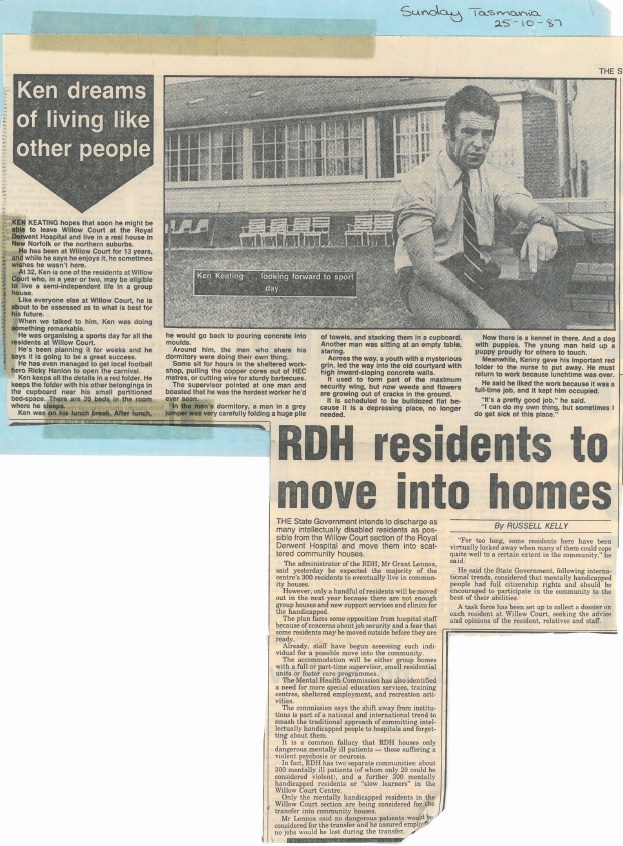Ward 10 was a high secure ward that was surrounded by a Ha Ha wall and was home for people with florid psychosis.
Large sign of things to come?
A large sign of things to come and a gem from the past, this stored sign is one of the artifacts ready for display in a new museum at the Barracks of Willow Court. While the community wait for the Derwent Valley Council to announce opening dates and activities, more artifacts keep coming in, or out of storage in readiness for a display of the history of the Hospital. The site was named the Royal Derwent Hospital after it’s Lachlan Park tag in 1968.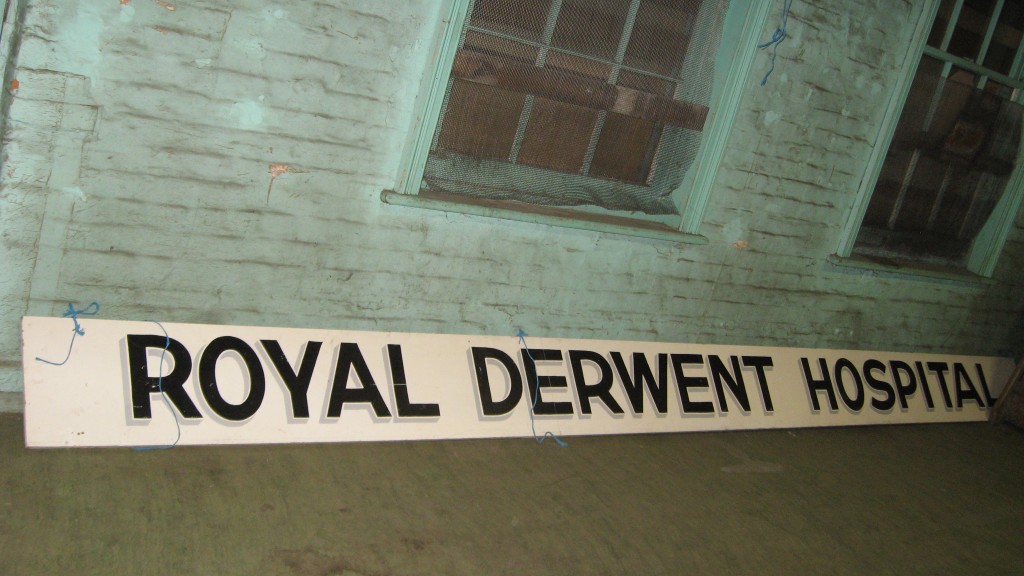
Complete book: Part B2 NEW Release
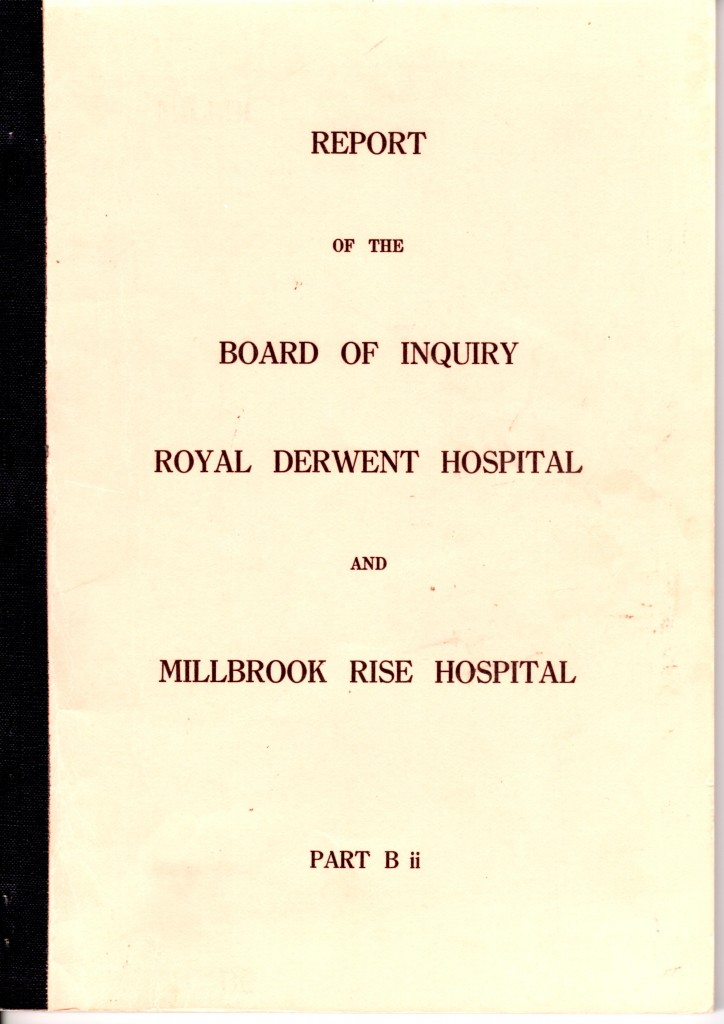 Complete book: Part B2 (terracotta cover) NEW Release (May 11th 2014) CLICK HERE
Complete book: Part B2 (terracotta cover) NEW Release (May 11th 2014) CLICK HERE
•• I wish to make it clear from the beginning that so many of the staff of the Royal Derwent Hospital have been kind. understanding, helpful and dedicated, and for the duties and general work they perform, they are deserving of tremendous credit.
Regretful is the fact that by activities and behaviours, misunderstandings, failure to correctly assess a patient’s limitations and such like. always appears to lead to undeserved and unwarranted adverse publicity which pervades the whole of the Royal Derwent Hospital .•• ”
Pages 189-332
Board of Inquiry, new book released for the first time.
Never publicly available before today, this is one of three volumes (blue cover) that we are scanning and releasing for all to read, study and make up their own minds about Royal Derwent Hospital and Mill Brook Rise and the care provided. These robust tested testimonies are proof that allegations were listened to and some proved and other unproved. Such a mixed history has left many different experiences for such a diverse community. Read and make up your own mind.
Complete book: Part B1 (blue cover) NEW!
” .. They had me by the throat and I was bruised all up the side there and I was that sore I could hardly damn well walk and I had jeans on … they we ripped off, and the buttons, there was only one button on and my bra were all showing you know. And when they got me across to A Ward I was thrown into a cell into a cell next to the visiting room, I was throw in there and left… “.
Pages 46-188 CLICK HERE
Appendix released in full.
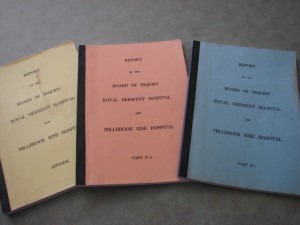 All three parts are now online from this first book for the first time in history. This is the account of Patient “A”, Patient “B” and Witness “9”. (Yellow Cover)
All three parts are now online from this first book for the first time in history. This is the account of Patient “A”, Patient “B” and Witness “9”. (Yellow Cover)
Patient “A”: “When about 12 months old, being ill, she was taken to the Norfolk District Hospital where severe gastro~enteritis was diagnosed. At 2 years of age she started having “funny little turns” which commenced a period of visitations to the Royal Hobart Hospital. When about seven she attended Tallre School but her hyperactivity was disruptive and the school authorities suggested, for the parents consideration, admission to Royal Derwent.”
Patient “B” is a seven year old male patient. ” we saw the children in M Ward and they were unkempt, dirty, and smelly and there was a general stench about the ward. We actually stepped over a child on the floor whom we knew. The child had been at the Quindalup Training Centre some six weeks before. The child had lost weight and its hair was so dirty it was matted. Another child was sitting on the floor with blood oozing out of its mouth. There were no toys around for the children to play with. When the Sister asked where the toys were she was told they were locked away because the children would break them… ”
Witness “9”: Child Care Worker. Allegations of assault upon infant patients by Staff of ‘M’ Ward. “I have heard about the Royal Derwent before I did go up there and I wanted to see It for myself. I wanted to, you know, just work there to, well, and partly to see children that I had worked with when they were very young, and I was curious to how they would be a few years after”
Minutes Willow Court Review 1988
Articles Page Free documentation about Willow Court.
Previously unreleased and unpublished:
Discussions about staffing arrangements from both Management and Staff representatives around the future of the Institutional Living Program. This paper outlines some of the actions and proposals for closure of wards and opening of Group homes. Present are Willow Court Management, Health Commission Management and Unions and professional bodies representing the very different levels of the workforce at Willow Court.
Report of the Board of Inquiry
These are three volumes and form part of the final unpublished report from the Board of Inquiry into the treatment practices at Royal Derwent Hospital and Mill Brook Rise Hospitals. Concluded approximately in 1979 the report heard from a number of parents and witnesses that had issues with the treatment and the duty of care of the hospital staff. Each witness was cross-examined in this formal hearing as were those accused of mistreatment and those that had seniority within the management structure. Some cases were dismissed and some were found to be correct accounts of what had occurred. The document draws heavily from the xerox transcript of evidence given by each participant. The Board had the power to summons witnesses to give evidence and it was clear that this was used to get reluctant witness to be interviewed and cross-examined. While there are many mixed views of the Hospital and it’s care provision throughout it’s life there were many inquiries both formal and in-formal held in the life of the institution.
Susan Piddock is an Australian renowned published author and authority on Australian Asylums and is studying Asylums throughout Australia. She has a keen interest in comparing institutions that started from a Convict past to those that had a free settler past as she believes there are key fundamental differences in the care provided through to the look and feel of the buildings. While that history is being written within academic circles the general history of each institution around Australia is being written, often by ex-staff who have/had a passion for the care provision given to patients who were admitted to institutions such as Royal Derwent Hospital.
One of my questions has always been, who is writing the history? It is often said that the victor writes the history of any human struggle and so that history will reflect one view, one perception of events. Often the patients that attended such institutions could not write the history and still would be limited to do so. This is were these documents come into play because they offer an evidence based and cross examined view of the events, judged by people whom have the qualifications, impartiality and experience to write this part of the history.
Of coarse there has to be a context and the documented witnesses even testify to the hard work and dedication of the majority of staff providing care withing these institutions. Also there needs to be a context of time around these documents, what was acceptable practice at the time and what is now? While many would view these documents as negative, they are part of the history, as mixed as it was. They serve the voiceless patients of this institution and those like it by looking into and investigating complaints, verifying and validating some experience and clearing the institution of any wrong doing in other cases.
Is this only valid for historical institutional settings or is it still valid today? It has become clear that where there are vulnerable people their will be abuse, it is a history that is still repeating it self today as it was in 1979 or 1879 for that matter. Resent cases in the United Kingdom serve as clear examples of abuse to a vulnerable population. So if the majority of people don’t participate in abusing actions or cover ups, why don’t they speak out? It is said that up to 70% of people will not get involved when there is an abuse being perpetrated and most fear in someway for reprisals should they step up to the mark and become that witness. History has also told that this is possible and probable when strong and aggressive personalities are allowed to permeate a care setting.
Undercover Care: The Abuse Exposed was a classic case of a workplace culture that was out of control and dominated by a small number of staff. Elder Abuse; Panorama BBC was another care provider that was exposed as delivering services that were abusing and less then best practice. Yet in an interview with Doctor Sheridan Forster in 2010 Dr Forster expressed that the best care provider for people with multiple learning disabilities PMLD that she has witnessed was an institution in the Netherlands. Dr Forster is one of Australia’s leading Academics in the support of PMLD here in Australia and has traveled and studied extensively in many countries. So it is not the institution that is abusive but the culture within a workplace/home that leads to less then best practices.
How does a care provider ensure that every step is taken to never expose a vulnerable person to abuse? We have criminal police checks, which most places, if not already mandatory, will have a policy and procedure in place to eliminate potential staff with relevant histories that have been historically exposed. Regular and unannounced visits from family, management and advocates should be welcomed in any care establishment and should be embedded within the culture of the home. A connection between the ever increasing divide of staff and management should be encouraged and employment practices should be reviewed inline with the latest evidence base practice. Strong laws that allow people with disabilities, especially those with intellectual disabilities to participate within the legal system. Whistle blower policy and procedures and independent investigation of suspicions activity and allegations should be funded and available. Support staff should also educate people to communicate about abuse when they recognise it.
Article from the Sunday Tasmanian 25-10-1987
This dual article writes about Ken and his hopes and dreams of leaving the Willow Court Centre as well as expressing his mixed feelings of leaving his home for the last 13 years. Ken’s journey and experience was not unlike the many residents that started the de-institutionalisation process that took another 13 years to complete.
The second part of this article quotes Royal Derwent Hospital’s Administrator, Mr Grant Lennox announcing that he expected the majority of the Centre’s 300 residents to eventually live in the community houses.
At the time this lead to much anxiety among staff and families who were concerned for their own situations and those of the residents and family members they knew so well.
Tasmania Library and TasTAFE referring people to this site!

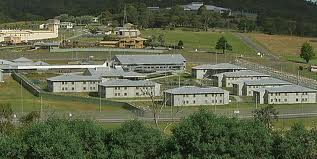
 A couple of weeks ago I visited the State Library to source some information about Willow Court/Royal Derwent Hospital and was delighted to find that they referred me to this website(Willow Court Advocacy Group). They said it was a great site for people studying the history of the hospital throughout time and through the eyes of the patients, families and also the staff.
A couple of weeks ago I visited the State Library to source some information about Willow Court/Royal Derwent Hospital and was delighted to find that they referred me to this website(Willow Court Advocacy Group). They said it was a great site for people studying the history of the hospital throughout time and through the eyes of the patients, families and also the staff.
We have been asked to supply our website to students studying Community Services while incarcerated at Risdon Prison on a local intranet which we have been please to do. It’s been great to have a good quality resource about the hospital history for students who are studying the past practices that the community had to support people living with a disability and/or mental health issues together in one place and in a respectful manner.
We have supplied teaching resources to high schools and guest speakers, often ex-staff and ex-patients to interested groups.
If you have anything to share about the history of Willow Court/Royal Derwent Hospital please contact us HERE, we would love to speak to you about sharing your historic knowledge, artefact, report or picture etc. We are able to professionally interview and present your knowledge and we can create a professional podcast to the highest industry standards.
Lachlan Park Hospital circa 1960
httpvh://youtu.be/Wk2CURa9SJA Lachlan Park Hospital circa 1950-60?. This footage shows the Barracks from the front and rear enclosed yard, H Ward and I Ward, the old clock tower and accommodation rooms on the west side of the hospital including the old metal fold up bed. This is very rare footage. Black & White silent footage which was given to us at Willow Court Tasmania Advocacy Group. We would like an accurate year that the footage was taken if anyone could help?
